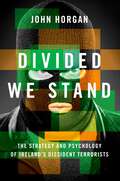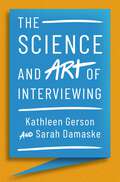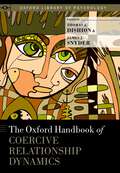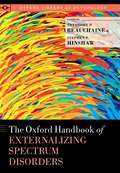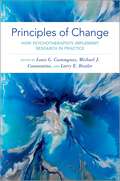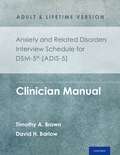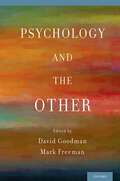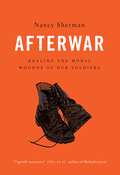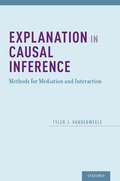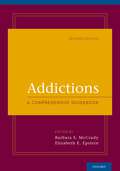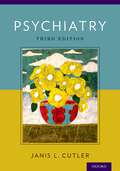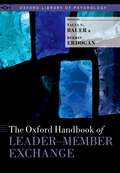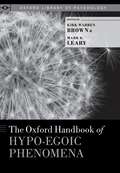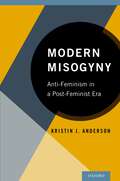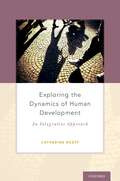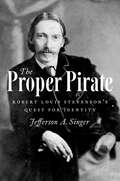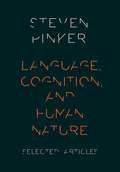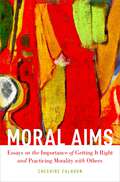- Table View
- List View
Divided We Stand: The Strategy and Psychology of Ireland's Dissident Terrorists
by John HorganTerrorism has returned to the streets of Northern Ireland. In the years after the 1998 Real IRA bombing of Omagh, which killed 29 people, violent dissident Republican groups have re-emerged as a major security threat to a region that has been denied peace, stability, and prosperity for too long. Those responsible have many names. They are breakaways, splinter factions, spoilers, and "residual" terrorists. The Real IRA, Continuity IRA, and Óglaigh na hÉireann are only some of the groups now responsible for a growing wave of bombings, shootings, threats, and intimidation across Northern Ireland. Commonly known as "the dissidents," these are the rejectionists for whom there seems to be no negotiated settlement, no peace deal, no consensus solution that will convince them to accept the will of the majority of the people on the island of Ireland. Divided We Stand: The Strategy and Psychology of Ireland's Dissident Terrorists presents the results of meticulous research conducted by the International Center for the Study of Terrorism at the Pennsylvania State University. Since 2007, John Horgan, Director of the center, has led a research project to monitor the activities of Ireland's new terrorists. Drawing on one of the largest open-source militant databases ever assembled, Divided We Stand describes the activities, histories, motivations, psychology, and strategy of the small, dynamic, and rapidly evolving splinter groups that continue to erode peace, stability, and normalization in Northern Ireland.
The Science and Art of Interviewing
by Kathleen Gerson Sarah DamaskeQualitative interviewing is among the most widely used methods in the social sciences, but it is arguably the least understood. In The Science and Art of Interviewing, Kathleen Gerson and Sarah Damaske offer clear, theoretically informed and empirically rich strategies for conducting interview studies. They present both a rationale and guide to the science-and art-of in-depth interviewing to take readers through all the steps in the research process, from the initial stage of formulating a question to the final one of presenting the results. Gerson and Damaske show readers how to develop a research design for interviewing, decide on and find an appropriate sample, construct a questionnaire, conduct probing interviews, and analyze the data they collect. At each stage, they also provide practical tips about how to address the ever-present, but rarely discussed challenges that qualitative researchers routinely encounter, particularly emphasizing the relationship between conducting well-crafted research and building powerful social theories. With an engaging, accessible style, The Science and Art of Interviewing targets a wide range of audiences, from upper-level undergraduates and graduate methods courses to students embarking on their dissertations to seasoned researchers at all stages of their careers.
SCIENCE & ART OF INTERVIEWING C
by Kathleen Gerson Sarah DamaskeQualitative interviewing is among the most widely used methods in the social sciences, but it is arguably the least understood. In The Science and Art of Interviewing, Kathleen Gerson and Sarah Damaske offer clear, theoretically informed and empirically rich strategies for conducting interview studies. They present both a rationale and guide to the science-and art-of in-depth interviewing to take readers through all the steps in the research process, from the initial stage of formulating a question to the final one of presenting the results. Gerson and Damaske show readers how to develop a research design for interviewing, decide on and find an appropriate sample, construct a questionnaire, conduct probing interviews, and analyze the data they collect. At each stage, they also provide practical tips about how to address the ever-present, but rarely discussed challenges that qualitative researchers routinely encounter, particularly emphasizing the relationship between conducting well-crafted research and building powerful social theories. With an engaging, accessible style, The Science and Art of Interviewing targets a wide range of audiences, from upper-level undergraduates and graduate methods courses to students embarking on their dissertations to seasoned researchers at all stages of their careers.
The Oxford Handbook of Coercive Relationship Dynamics (Oxford Library of Psychology)
Coercive interactions and conflict are commonplace in close relationships and families, friendships, and teacher-student relationships in schools. Coercion and conflict can be used to grow stronger relationships, or they can lead to the deterioration of relationships, undermine efforts to socialize and teach youth, and lead to the development of mental health problems in children and parents. Coercion theory helps shed light on how these daily interaction dynamics explain the development of aggression, marital conflict, depression, and severe mental health problems in families and how they undermine school safety and effectiveness. The Oxford Handbook of Coercive Relationship Dynamics features the most recent, innovative applications of coercion theory to understanding psychopathology, developmental theory, and intervention science. The volume provides a multidisciplinary perspective on coercive processes, origins, and social functions to anchor coercion theory from multiple perspectives and to lay a theoretical and empirical foundation for innovative expansion of the coercion model to new areas of research. The volume gives specific examples of how the basic coercive processes underlie the development of significant suffering in children and families, and chapters include clinically oriented discussions of research on the role of coercion in the causation and amplification of problem behavior and emotional distress. The internationally renowned authors of this volume highlight scientific advances in the study of coercive dynamics in families and close relationships, account for physiological and genetic correlates of coercive dynamics, and discuss the application of coercion theory to effective interventions that improve the quality and well-being of children, adolescents, and adults. This volume is an invaluable resource on behavioral science methodology, developmental theory, and intervention science.
The Oxford Handbook of Externalizing Spectrum Disorders (Oxford Library of Psychology)
Recent developments in the conceptualization of externalizing spectrum disorders, including attention-deficit/hyperactivity disorder, conduct disorder, antisocial personality disorder, and substance use disorders, suggest common genetic and neural substrates. Despite this, neither shared vulnerabilities nor their implications for developmental models of externalizing conduct are captured by prevailing nosologic and diagnostic systems, such as the DSM-5. The Oxford Handbook of Externalizing Spectrum Disorders is the first book of its kind to capture the developmental psychopathology of externalizing spectrum disorders by examining causal factors across levels of analysis and developmental epochs, while departing from the categorical perspective. World renowned experts on externalizing psychopathology demonstrate how shared genetic and neural vulnerabilities predispose to trait impulsivity, a highly heritable personality construct that is often shaped by adverse environments into increasingly intractable forms of externalizing conduct across development. Consistent with contemporary models of almost all forms of psychopathology, the Handbook emphasizes the importance of neurobiological vulnerability and environmental risk interactions in the expression of externalizing behavior across the lifespan. The volume concludes with an integrative, ontogenic process model of externalizing psychopathology in which diverse equifinal and multifinal pathways to disorder are specified.
Principles of Change: How Psychotherapists Implement Research in Practice
Principles of Change constitutes a new approach to evidence-based practice in psychotherapy that goes beyond the traditional and unidirectional dissemination of research, whereby clinicians are typically viewed as passive recipients of scientific findings. Based on an extensive review of literature, it first offers a list of 38 empirically based principles of change grouped in five categories: client prognostic, treatment/provider moderating, client process, therapeutic relationship, and therapist interventions. Six therapists from diverse theoretical orientations then describe, in rich and insightful detail, how they implement each of these principles. The book also offers exchanges between researchers and clinicians on several key issues, including: how similarly and differently change principles are addressed or used across a variety of treatments; and how clinicians' observations and reflections can guide future research. By presenting together these unique yet complementary experiences, Principles of Change will support synergetic advances in understanding and improving psychotherapy, laying the foundation for further collaborations and partnerships between stakeholders in mental health services.
Anxiety and Related Disorders Interview Schedule for DSM-5®: Clinician Manual (Treatments That Work)
by Timothy A. Brown David H. BarlowThe Anxiety and Related Disorders Interview Schedule for DSM-5® (ADIS-5) Clinician Manual accompanies both the Adult and Lifetime versions of the ADIS-5 Client Interview Schedules. The interview schedules are designed to diagnose anxiety, mood, obsessive-compulsive, trauma, and related disorders (e.g., somatic symptom, substance use) and to permit differential diagnosis among these disorders according to DSM-5® criteria (American Psychiatric Association, 2013). The Clinician Manual provides information for the clinician about uses of the ADIS-5, changes introduced in the ADIS-5, coverage of the ADIS-5, organization of diagnostic sections, how to administer the ADIS-5, and more.
Psychology and the Other
The figure of the Other is an important though underutilized vehicle for exploring and reconceptualizing classic psychological and philosophical issues, from identity and purpose to human frailty and suffering. Moreover, it can be used to reorient inquiry toward aspects of the human condition that are often regarded as secondary or peripheral--for instance, our responsibility to others and to the environment. A broad spectrum of disciplines including psychology, philosophy, theology, and religious studies speak about the challenges we face in encountering the Other vis-à-vis our receptivity, openness, and capacity to entertain the stranger in our midst. Through constructive critical exchange, Psychology and the Other engages such perspectives on the Other from various subdisciplines within psychology and related disciplines. The volume uses the language of the Other as a vehicle for rethinking aspects of psychological processes, especially within the therapeutic context. As a group, the contributors demonstrate that the language of the Other may be more fitting than the egocentric language frequently employed in psychology. They also embrace the challenge to create new theories and practices that are more ethically attuned to the dynamic realities of psychological functioning. The book is organized into three sections. The first deals with foundational philosophical concerns and provides an introduction to the project of "thinking Otherwise." The second section brings these fundamental philosophical concerns to bear on the therapeutic situation, especially in the realm of relational psychoanalysis. The final section of the book addresses concrete psychological situations in which the Other figures prominently and where the power of thinking Otherwise is most visibly demonstrated.
PSYCHOLOGY & THE OTHER C
by David Goodman and Mark FreemanThe figure of the Other is an important though underutilized vehicle for exploring and reconceptualizing classic psychological and philosophical issues, from identity and purpose to human frailty and suffering. Moreover, it can be used to reorient inquiry toward aspects of the human condition that are often regarded as secondary or peripheral--for instance, our responsibility to others and to the environment. A broad spectrum of disciplines including psychology, philosophy, theology, and religious studies speak about the challenges we face in encountering the Other vis-à-vis our receptivity, openness, and capacity to entertain the stranger in our midst. Through constructive critical exchange, Psychology and the Other engages such perspectives on the Other from various subdisciplines within psychology and related disciplines. The volume uses the language of the Other as a vehicle for rethinking aspects of psychological processes, especially within the therapeutic context. As a group, the contributors demonstrate that the language of the Other may be more fitting than the egocentric language frequently employed in psychology. They also embrace the challenge to create new theories and practices that are more ethically attuned to the dynamic realities of psychological functioning. The book is organized into three sections. The first deals with foundational philosophical concerns and provides an introduction to the project of "thinking Otherwise." The second section brings these fundamental philosophical concerns to bear on the therapeutic situation, especially in the realm of relational psychoanalysis. The final section of the book addresses concrete psychological situations in which the Other figures prominently and where the power of thinking Otherwise is most visibly demonstrated.
Afterwar: Healing the Moral Wounds of Our Soldiers
by Nancy ShermanMovies like American Sniper and The Hurt Locker hint at the inner scars our soldiers incur during service in a war zone. The moral dimensions of their psychological injuries--guilt, shame, feeling responsible for doing wrong or being wronged-elude conventional treatment. Georgetown philosophy professor Nancy Sherman turns her focus to these moral injuries in Afterwar. She argues that psychology and medicine alone are inadequate to help with many of the most painful questions veterans are bringing home from war. Trained in both ancient ethics and psychoanalysis, and with twenty years of experience working with the military, Sherman draws on in-depth interviews with servicemen and women to paint a richly textured and compassionate picture of the moral and psychological aftermath of America's longest wars. She explores how veterans can go about reawakening their feelings without becoming re-traumatized; how they can replace resentment with trust; and the changes that need to be made in order for this to happen-by military courts, VA hospitals, and the civilians who have been shielded from the heaviest burdens of war. 2.6 million soldiers are currently returning home from war, the greatest number since Vietnam. Facing an increase in suicides and post-traumatic stress, the military has embraced measures such as resilience training and positive psychology to heal mind as well as body. Sherman argues that some psychological wounds of war need a kind of healing through moral understanding that is the special province of philosophical engagement and listening.
Afterwar: Healing the Moral Wounds of Our Soldiers
by Nancy ShermanMovies like American Sniper and The Hurt Locker hint at the inner scars our soldiers incur during service in a war zone. The moral dimensions of their psychological injuries--guilt, shame, feeling responsible for doing wrong or being wronged-elude conventional treatment. Georgetown philosophy professor Nancy Sherman turns her focus to these moral injuries in Afterwar. She argues that psychology and medicine alone are inadequate to help with many of the most painful questions veterans are bringing home from war. Trained in both ancient ethics and psychoanalysis, and with twenty years of experience working with the military, Sherman draws on in-depth interviews with servicemen and women to paint a richly textured and compassionate picture of the moral and psychological aftermath of America's longest wars. She explores how veterans can go about reawakening their feelings without becoming re-traumatized; how they can replace resentment with trust; and the changes that need to be made in order for this to happen-by military courts, VA hospitals, and the civilians who have been shielded from the heaviest burdens of war. 2.6 million soldiers are currently returning home from war, the greatest number since Vietnam. Facing an increase in suicides and post-traumatic stress, the military has embraced measures such as resilience training and positive psychology to heal mind as well as body. Sherman argues that some psychological wounds of war need a kind of healing through moral understanding that is the special province of philosophical engagement and listening.
Explanation in Causal Inference: Methods for Mediation and Interaction
by Tyler VanderWeeleThe book provides an accessible but comprehensive overview of methods for mediation and interaction. There has been considerable and rapid methodological development on mediation and moderation/interaction analysis within the causal-inference literature over the last ten years. Much of this material appears in a variety of specialized journals, and some of the papers are quite technical. There has also been considerable interest in these developments from empirical researchers in the social and biomedical sciences. However, much of the material is not currently in a format that is accessible to them. The book closes these gaps by providing an accessible, comprehensive, book-length coverage of mediation. The book begins with a comprehensive introduction to mediation analysis, including chapters on concepts for mediation, regression-based methods, sensitivity analysis, time-to-event outcomes, methods for multiple mediators, methods for time-varying mediation and longitudinal data, and relations between mediation and other concepts involving intermediates such as surrogates, principal stratification, instrumental variables, and Mendelian randomization. The second part of the book concerns interaction or "moderation," including concepts for interaction, statistical interaction, confounding and interaction, mechanistic interaction, bias analysis for interaction, interaction in genetic studies, and power and sample-size calculation for interaction. The final part of the book provides comprehensive discussion about the relationships between mediation and interaction and unites these concepts within a single framework. This final part also provides an introduction to spillover effects or social interaction, concluding with a discussion of social-network analyses. The book is written to be accessible to anyone with a basic knowledge of statistics. Comprehensive appendices provide more technical details for the interested reader. Applied empirical examples from a variety of fields are given throughout. Software implementation in SAS, Stata, SPSS, and R is provided. The book should be accessible to students and researchers who have completed a first-year graduate sequence in quantitative methods in one of the social- or biomedical-sciences disciplines. The book will only presuppose familiarity with linear and logistic regression, and could potentially be used as an advanced undergraduate book as well.
Addictions: A Comprehensive Guidebook
by Barbara S. McCrady Elizabeth E. EpsteinIn the 14 years since the first edition of Addictions was published, a wealth of substantive and crucial new findings have been added to our knowledge of alcohol and other substance use disorders. This primary reference has now been updated and expanded to include 38 chapters, all completely rewritten to reflect new knowledge gained about the science of alcohol and other drugs, as well as new treatment approaches and research trends. Addictions: A Comprehensive Guidebook, Second Edition, features a roster of senior scientists covering the latest findings in the study of alcohol and other drug use, abuse, and dependence. Skillfully edited by Drs. Barbara S. McCrady and Elizabeth E. Epstein, the chapters primarily review the literature published in the last 14 years since the first edition. The volume covers seven different content areas: Section I addresses broad conceptual issues as well as information on the etiology, neuroscience, epidemiology and course of alcohol and other drug use, abuse, and dependence. Section II provides detailed pharmacological and clinical information on the major drugs of abuse, including alcohol. Sections III, IV, and V focus on knowledge of importance to clinical practice, including a section on assessment and treatment planning, information on a range of empirically supported treatments, and issues related to clinical practice. Section VI provides information about specific population groups, and Section VII addresses policy, prevention, and economic issues in the field. The book is appropriate for a wide variety of readers who are either treating, learning to treat, doing research on, or teaching about addictions. Comprehensive and succinct, it is written in a manner that is accessible and useful to practitioners, students, clinician trainees, and researchers. It is also an ideal textbook for graduate courses and training programs in psychology, psychiatry, social work, and addictions certifications, and for advanced undergraduate courses on alcohol and other substance use disorders
Psychiatry
by Janis CutlerFully updated for DSM-5 and designed specifically for medical students, as well as other trainees in the heath professions, Psychiatry 3e is a dynamic introductory textbook in psychiatry. Ideally suited for first and second year medical students during their psychopathology course and third year medical students during their psychiatry clerkship, the material is presented in a clear, concise, and practical manner perfect for exam preparation. The authors provide a thorough yet concise introduction to clinical psychiatry, focusing on basic clinical skills like recognition and assessment of psychiatric illness. Clinically relevant information is emphasized, including practical interviewing techniques. Psychiatry 3e also uses case studies, DSM-5 guidelines, and extensive tables offset from the text to act as a comprehensive yet concise guide for the busy medical student studying for exams. In response to DSM-5, the third edition has been reorganised and fully updated to include the new disorders and classification of psychiatric illness.
Psychiatry
by Janis L. CutlerFully updated for DSM-5 and designed specifically for medical students, as well as other trainees in the heath professions, Psychiatry 3e is a dynamic introductory textbook in psychiatry. Ideally suited for first and second year medical students during their psychopathology course and third year medical students during their psychiatry clerkship, the material is presented in a clear, concise, and practical manner perfect for exam preparation. The authors provide a thorough yet concise introduction to clinical psychiatry, focusing on basic clinical skills like recognition and assessment of psychiatric illness. Clinically relevant information is emphasized, including practical interviewing techniques. Psychiatry 3e also uses case studies, DSM-5 guidelines, and extensive tables offset from the text to act as a comprehensive yet concise guide for the busy medical student studying for exams. In response to DSM-5, the third edition has been reorganised and fully updated to include the new disorders and classification of psychiatric illness.
The Oxford Handbook of Leader-Member Exchange (Oxford Library of Psychology)
Leader-member exchange (LMX) is the foremost dyadic theory in the leadership literature. Whereas contemporary leadership theories such as transformational, servant, or authentic leadership theories focus on the effects of leader behaviors on employee attitudes, motivation, and team outcomes, relational leadership theory views the dyadic relationship quality between leaders and members as the key to understanding leader effects on members, teams, and organizations. This approach views trust- and respect-based relationships as the cornerstone of leadership. LMX has grown from a new theory in the 1970s to a mature area of research in 2015. Interest in this theory has increased rapidly over the past four decades, and the pace of research in this area continues to accelerate dramatically. The Oxford Handbook of Leader-Member Exchange takes stock of the literature to examine its roots, what is currently known, what research gaps may exist, and what areas are in need of the most urgent research.
The Oxford Handbook of Leader-Member Exchange (Oxford Library of Psychology)
by Talya N. Bauer Berrin ErdoganLeader-member exchange (LMX) is the foremost dyadic theory in the leadership literature. Whereas contemporary leadership theories such as transformational, servant, or authentic leadership theories focus on the effects of leader behaviors on employee attitudes, motivation, and team outcomes, relational leadership theory views the dyadic relationship quality between leaders and members as the key to understanding leader effects on members, teams, and organizations. This approach views trust- and respect-based relationships as the cornerstone of leadership. LMX has grown from a new theory in the 1970s to a mature area of research in 2015. Interest in this theory has increased rapidly over the past four decades, and the pace of research in this area continues to accelerate dramatically. The Oxford Handbook of Leader-Member Exchange takes stock of the literature to examine its roots, what is currently known, what research gaps may exist, and what areas are in need of the most urgent research.
The Oxford Handbook of Hypo-egoic Phenomena (Oxford Library of Psychology)
Egoicism, a mindset that places primary focus upon oneself, is rampant in contemporary Western cultures as commercial advertisements, popular books, song lyrics, and mobile apps consistently promote self-interest. Consequently, researchers have begun to address the psychological, interpersonal, and broader societal costs of excessive egoicism and to investigate alternatives to a "me and mine first" mindset. For centuries, scholars, spiritual leaders, and social activists have advocated a "hypo-egoic" way of being that is characterized by less self-concern in favor of a more inclusive "we first" mode of functioning. In recent years, investigations of hypo-egoic functioning have been examined by psychologists, cognitive scientists, neuroscientists, and philosophers. Edited by Kirk Warren Brown and Mark R. Leary, The Oxford Handbook of Hypo-egoic Phenomena brings together an expert group of contributors to examine these groundbreaking lines of inquiry, distilling current knowledge about hypo-egoicism into an exceptional resource. In this volume, readers will fi nd theoretical perspectives from philosophy and several major branches of psychology to inform our understanding of the nature of hypo-egoicism and its expressions in various domains of life. Further, readers will encounter psychological research discoveries about particular phenomena in which hypo-egoicism is a prominent feature, demonstrating its implications for well-being, regulation of emotion, adaptive decision-making, positive social relations, and other markers of human happiness, well-being, and health. This Handbook offers the most comprehensive and thoughtful analyses of hypo-egoicism to date.
Modern Misogyny: Anti-Feminism in a Post-Feminist Era
by Kristin J. AndersonPundits and politicians often opine on the irrelevance of feminism and the women's movement today. Some commentators describe the state of feminism as "post-feminist," alongside equally questionable claims of Barack Obama's election as signaling a "post-racial" America. Modern Misogyny examines contemporary anti-feminism in a "post-feminist" era. It considers the widespread notion that the feminist movement has ended, in large part because the work of feminism has been completed. In fact, the argument goes, women have been so successful in achieving equality, it is now men who currently are at risk of becoming irrelevant and unnecessary. These sentiments make up modern anti-feminism. Modern Misogyny argues that equality has not been fully achieved and that anti-feminism is now packaged in a more palatable, but stealthy form. This book addresses the nature, function, and implications of modern anti-feminism in the United States. Modern Misogyny explores the landscape of popular culture and politics, emphasizing relatively recent moves away from feminist activism to individualism and consumerism where "self-empowerment" represents women's progress. It also explores the retreat to traditional gender roles after September 11, 2001. It interrogates the assumption that feminism is unnecessary, that women have achieved equality, and therefore those women who do insist on being feminists want to get ahead of men. Finally, it takes a fresh look at the positive role that feminism plays in today's "post-feminist" era, and how feminism does and might function in women's lives. Post-feminist discourse encourages young women to believe that they were born into a free society, so if they experience discrimination, it is an individual, isolated problem that may even be their own fault. Modern Misogyny examines that rendering of feminism as irrelevant and as the silencing and marginalizing of feminists. Anderson calls for a revived feminism that is vigilant in combatting modern forms of sexism.
Modern Misogyny: Anti-Feminism in a Post-Feminist Era
by Kristin J. AndersonPundits and politicians often opine on the irrelevance of feminism and the women's movement today. Some commentators describe the state of feminism as "post-feminist," alongside equally questionable claims of Barack Obama's election as signaling a "post-racial" America. Modern Misogyny examines contemporary anti-feminism in a "post-feminist" era. It considers the widespread notion that the feminist movement has ended, in large part because the work of feminism has been completed. In fact, the argument goes, women have been so successful in achieving equality, it is now men who currently are at risk of becoming irrelevant and unnecessary. These sentiments make up modern anti-feminism. Modern Misogyny argues that equality has not been fully achieved and that anti-feminism is now packaged in a more palatable, but stealthy form. This book addresses the nature, function, and implications of modern anti-feminism in the United States. Modern Misogyny explores the landscape of popular culture and politics, emphasizing relatively recent moves away from feminist activism to individualism and consumerism where "self-empowerment" represents women's progress. It also explores the retreat to traditional gender roles after September 11, 2001. It interrogates the assumption that feminism is unnecessary, that women have achieved equality, and therefore those women who do insist on being feminists want to get ahead of men. Finally, it takes a fresh look at the positive role that feminism plays in today's "post-feminist" era, and how feminism does and might function in women's lives. Post-feminist discourse encourages young women to believe that they were born into a free society, so if they experience discrimination, it is an individual, isolated problem that may even be their own fault. Modern Misogyny examines that rendering of feminism as irrelevant and as the silencing and marginalizing of feminists. Anderson calls for a revived feminism that is vigilant in combatting modern forms of sexism.
Exploring the Dynamics of Human Development: An Integrative Approach
by Catherine RaeffResearchers and students in developmental psychology have pointed out that the numerous findings from research about human development seem disconnected and that it is difficult to fit fragmented bits of information together. Studies of separate domains of functioning (e.g., cognition, emotion, language, social relationships, identity) divide the field and there are increasing calls for integrative conceptions of human development. In Exploring the Dynamics of Human Development, Dr. Catherine Raeff constructs a theoretical framework that enables readers to reconcile seemingly disparate information by thinking systematically about dynamic developmental processes. This approach integrates systems theory, organismic-developmental theory, and sociocultural theory, as well as research across cultures and the life span. Raeff brings developmental processes into coherence by building a unified theoretical framework that is organized around the following questions: What develops during development?; What happens during development?; and How does development happen? Using a wide range of illustrative empirical examples, Raeff conceptualizes what happens during development in terms of differentiation and integration and explains how development happens through individual, social, and cultural processes. The framework helps to overcome confusion in the field and explore issues such as individual and cultural variability, looking beyond age-based changed to understand development, and resolving fragmentation by starting with whole person functioning. The framework also opens up new directions for research. This book will be useful to developmentalists, graduate students, upper level undergraduates, and others who seek an integrative understanding of the field as a whole and a systematic way of thinking about and investigating human action and development.
The Proper Pirate: Robert Louis Stevenson's Quest for Identity
by Jefferson A. SingerExploring the life and times of author Robert Louis Stevenson, The Proper Pirate takes readers on a psychological journey from the writer's religious and constricted upbringing to a life of imagination and wonder culminating in the South Seas island of Samoa. Drawing on contemporary theories of identity development, Jefferson A. Singer traces how Stevenson overcame Victorian dualities of piety versus passion in both his personal life and artistic works, gradually edging toward a more Modernist and complicated moral vision. This first full-length psychobiographical study of Stevenson follows the trajectory of his life, all while highlighting how key memories and conflicts within his personality shaped the narrative structure and themes of some of his most celebrated works, including: Treasure Island, Strange Case of Dr. Jekyll and Mr. Hyde, A Child's Garden of Verses, and Kidnapped. Stevenson's relationships to his parents, his wife Fanny, and circle of intimate friends also play a prominent role in this investigation of his emerging identity and artistic body of work.
The Proper Pirate: Robert Louis Stevenson's Quest for Identity
by Jefferson A. SingerExploring the life and times of author Robert Louis Stevenson, The Proper Pirate takes readers on a psychological journey from the writer's religious and constricted upbringing to a life of imagination and wonder culminating in the South Seas island of Samoa. Drawing on contemporary theories of identity development, Jefferson A. Singer traces how Stevenson overcame Victorian dualities of piety versus passion in both his personal life and artistic works, gradually edging toward a more Modernist and complicated moral vision. This first full-length psychobiographical study of Stevenson follows the trajectory of his life, all while highlighting how key memories and conflicts within his personality shaped the narrative structure and themes of some of his most celebrated works, including: Treasure Island, Strange Case of Dr. Jekyll and Mr. Hyde, A Child's Garden of Verses, and Kidnapped. Stevenson's relationships to his parents, his wife Fanny, and circle of intimate friends also play a prominent role in this investigation of his emerging identity and artistic body of work.
Language, Cognition, and Human Nature: Selected Articles
by Steven PinkerLanguage, Cognition, and Human Nature collects together for the first time much of Steven Pinker's most influential scholarly work on language and cognition. Pinker's seminal research explores the workings of language and its connections to cognition, perception, social relationships, child development, human evolution, and theories of human nature. This eclectic collection spans Pinker's thirty-year career, exploring his favorite themes in greater depth and scientific detail. It includes thirteen of Pinker's classic articles, ranging over topics such as language development in children, mental imagery, the recognition of shapes, the computational architecture of the mind, the meaning and uses of verbs, the evolution of language and cognition, the nature-nurture debate, and the logic of innuendo and euphemism. Each outlines a major theory or takes up an argument with another prominent scholar, such as Stephen Jay Gould, Noam Chomsky, or Richard Dawkins. Featuring a new introduction by Pinker that discusses his books and scholarly work, this collection reflects essential contributions to cognitive science by one of our leading thinkers and public intellectuals.
Moral Aims: Essays on the Importance of Getting It Right and Practicing Morality with Others
by Cheshire CalhounWe rely on two different conceptions of morality. On the one hand, we think of morality as a correct action guide. Morality is accessed by taking up a critical, reflective point of view where our concern is with identifying the moral rules that would be the focus of the requiring activities of persons in a hypothetical social world whose participants were capable of accessing the justifications for everyone's endorsing just this set of rules. On the other hand, in doing virtually anything connected with morality--making demands, offering excuses, justifying choices, expressing moral attitudes, getting uptake on our resentments, and the like-we rely on social practices of morality and shared moral understandings that make our moral activities and attitudes intelligible to others. This second conception of morality, unlike the first, is not shaped by the aim of getting it right or the contrast between correct and merely supposed moral requirements. It is shaped by the moral aim of practicing morality with others within an actual, not merely hypothetical, scheme of social cooperation. If practices based on misguided moral norms seem not to be genuine morality under the first conception, merely hypothetical practices seem not to be the genuine article under the second conception. The premise of this book, which collects together nine previously published essay and a new introduction, is that both conceptions are indispensable. But exactly how is the moral theorist to go about working simultaneously with two such different conceptions of morality? The book's project is not to construct an overarching methodology for handling the two conceptions of morality. Instead, it is to provide case studies of that work being done.
